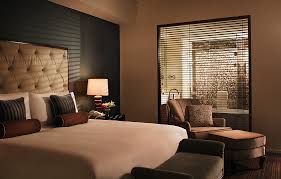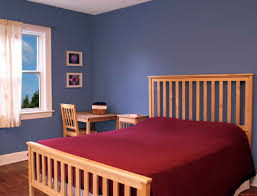Paint Ideas For Bedrooms Biography
source(google.com.pk)Though scientists don’t completely understand the link between color and mood, it is a scientific fact that color affects mood. And since the colors we choose to live in can definitely affect how we act, think and feel, we should certainly consider the personality of color when choosing a room’s color scheme.
But what room colors influence what moods? We often talk about being green with envy or feeling blue, but are these colors really indicative of these attitudes? To help you choose room colors that fit your personality, climate and objective, let’s explore a little color psychology to discover how room color affects mood.
Tip: The personalities of the colors below are most important when used as a room’s dominant color. Keep in mind that various shades of the same color can evoke different moods. For example, red (which is an aggressive color) gives off a completely different vibe than pink (which has been proven to reduce aggressive behavior).
Room Color & Mood: Warm & Cool Colors
When choosing a room’s color scheme, remember that balance is best achieved with a mix of warm and cool colors.
Warm Colors
Warm colors, located on one side of the color wheel, are colors with warm undertones such as red-orange, reds, yellows and yellow-greens. These colors are radiant and cozy. Because warm colors seem to advance, they make small rooms appear smaller and large rooms more intimate.
Cool Colors
Cool colors, located opposite warm colors on the color wheel, are colors with cool undertones and include purples, blues and blue-greens. These colors can have a calming effect. In a room, cool colors appear to recede, making a room appear larger. Because these tones can make a room feel colder, these colors work well in a sunny room and may not be as comforting in a room with little natural light.
Neutral Colors
In regards to the technical definition of colors, the neutral colors (or non-colors) are white, gray and black, but in decorating, neutral colors have a wider definition and encompass a large range of colors. In decorating, grays and blacks have either warm or cool undertones and typically fall into one of the two categories above. For more on the personalities of neutral colors, see this article.
Room Color & Mood: Primary Colors
Primary colors can evoke feelings of a bad day at preschool, so when using these colors – either alone or together – don't go overboard. To create a mature ambiance with primary colors, mix with warm tones, like natural fibers and textures.
Blue
Blues can relax, soothe, and calm us. Blue is a popular choice for bedrooms for just this reason. Blues can also improve focus and productivity, so a calming blue might be the right choice for an office or child’s study area. Blue is also considered to be a clean color, so it works well in bathrooms and laundry areas. However, dark blues can invoke feelings of sadness, and all blues can appear a little chilly, especially in rooms with little natural light. In these rooms, choose blues with warm or muted tones.
Red
Red is associated with passion and energy, as well as being a bit racy. Red can raise energy levels – it has been shown to increase blood pressure and heart rate – and is known for stimulating appetites and conversation. If you would like to paint your bedroom or living room red, look for muted, rich reds which have a softer and more elegant look.
Yellow
Yellow makes many people feel cheerful, energetic, and happy, yet the color yellow – especially the brighter shades – can cause fatigue and anxiety with overuse. Soft, buttery yellows are easier to live with in the long run. Soft yellows are also easier on the eyes and more calming than bright yellows. Yellow reflects light and is perfect for poorly lit rooms, also making it a great choice for a ceiling color.
When painting a bedroom for yourself, any color that makes you feel relaxed is appropriate. As the article "Psychology of Color" points out, the meaning of color is cultural and personal--while red may soothe one person's nerves, it may make another feel jumpy. However, if you are painting a small bedroom for possible resale, your goals are to make the space look as large as possible and to appeal to the widest audience. Speak to your real estate agent for more information about the best paint colors for your area.
Sponsored Link
UK Furniture Rental
From the Professionals. All Styles, Finest Quality. Amazing Prices Now!
www.emblemfurniture.co.uk
Earth Tones
Earth tones technically include any color that occurs in nature; however, in design the term typically refers to muted tones of beige, brown, orange and yellow. Earth tones are frequently used in craftsman, bungalow and modern architecture. Light earth tones in shades of sand or beige help a small bedroom look larger and brighter. As neutral colors, they appeal to a large number of potential buyers.
Serene Colors
Shades of blue and green are often chosen for a bedroom because they are thought to invoke a feeling of peace and relaxation. Avoid deeply saturated shades of blue or green in a small bedroom as too much color can make a small room appear cramped and busy. Colors like sage green and sky blue are are more likely to have mass appeal than bolder choices such as pine or turquoise.
No Matches Found. Please try your search again.
White and Off-White
Shades of white and off-white are useful in a small bedroom because of the light and and sense of space they create in a room. However, a white room can also look cold and stark. Consider off-white shades such as cream, ivory, light gray and pearl instead of pure white if you want to make the bedroom appear cozier. In all cases, a white ceiling is useful in a small room for creating an illusion of greater height.
Style
The bright and bold use of colour in Vincent's Bedroom in Arles is typical of the vibrant palette he began to use beginning late in his Paris period. Yellow was Van Gogh's favourite colour throughout his Arles and Saint-Rémy period--whether outdoors in wheatfields under the Provencal sun or indoor works such as the bedroom.
Probably the most striking and unusual aspect of the painting is the peculiar perspective. The work is unrealistic in its warped portrayal of the bedroom, with the subjects skewed downward toward the viewer. This is one of the aspects that makes the painting so unique and easily recognizable. The perspective seems extreme, but later in his career as an artist Van Gogh was not only rebelling against the muted colours of the Dutch artists of the time, he was also breaking free from the confines of the perspective frame which dictated a precise and realistic approach to a work's perspective. Van Gogh often rejected conventional perspective in the latter half of his career as an artist--particularly in many of his Arles paintings (see The Seated Zouave and The Night Cafe in the Place Lamartine in Arles, for example).
Interestingly, the unusual perspective isn't necessarily explained solely because of Van Gogh's conscious stylistic choice. Ronald Pickvance in his book Van Gogh in Arles suggests an explanation based more on architectural fact than artistic preference. Pickvance explains that the very shape of Van Gogh's room was unusual and, as a result, Van Gogh's portrayal of it is actually more realistic than the viewer might initially imagine. The diagram at right shows the actual shape of Van Gogh's room.2 Note the slant to the outer wall which, when depicted in Van Gogh's painting, adds to the unusual perspective.
Paint Ideas For Bedrooms Painting Ideas for Kids For Livings Room Canvas for Bedrooms for Begginners art For Kids on Canvas for Home For Walls for Kitchen

Paint Ideas For Bedrooms Painting Ideas for Kids For Livings Room Canvas for Bedrooms for Begginners art For Kids on Canvas for Home For Walls for Kitchen

Paint Ideas For Bedrooms Painting Ideas for Kids For Livings Room Canvas for Bedrooms for Begginners art For Kids on Canvas for Home For Walls for Kitchen

Paint Ideas For Bedrooms Painting Ideas for Kids For Livings Room Canvas for Bedrooms for Begginners art For Kids on Canvas for Home For Walls for Kitchen

Paint Ideas For Bedrooms Painting Ideas for Kids For Livings Room Canvas for Bedrooms for Begginners art For Kids on Canvas for Home For Walls for Kitchen

Paint Ideas For Bedrooms Painting Ideas for Kids For Livings Room Canvas for Bedrooms for Begginners art For Kids on Canvas for Home For Walls for Kitchen

Paint Ideas For Bedrooms Painting Ideas for Kids For Livings Room Canvas for Bedrooms for Begginners art For Kids on Canvas for Home For Walls for Kitchen
Paint Ideas For Bedrooms Painting Ideas for Kids For Livings Room Canvas for Bedrooms for Begginners art For Kids on Canvas for Home For Walls for Kitchen

Paint Ideas For Bedrooms Painting Ideas for Kids For Livings Room Canvas for Bedrooms for Begginners art For Kids on Canvas for Home For Walls for Kitchen

Paint Ideas For Bedrooms Painting Ideas for Kids For Livings Room Canvas for Bedrooms for Begginners art For Kids on Canvas for Home For Walls for Kitchen


Paint Ideas For Bedrooms Painting Ideas for Kids For Livings Room Canvas for Bedrooms for Begginners art For Kids on Canvas for Home For Walls for Kitchen

Paint Ideas For Bedrooms Painting Ideas for Kids For Livings Room Canvas for Bedrooms for Begginners art For Kids on Canvas for Home For Walls for Kitchen

Paint Ideas For Bedrooms Painting Ideas for Kids For Livings Room Canvas for Bedrooms for Begginners art For Kids on Canvas for Home For Walls for Kitchen

Paint Ideas For Bedrooms Painting Ideas for Kids For Livings Room Canvas for Bedrooms for Begginners art For Kids on Canvas for Home For Walls for Kitchen
Paint Ideas For Bedrooms Painting Ideas for Kids For Livings Room Canvas for Bedrooms for Begginners art For Kids on Canvas for Home For Walls for Kitchen

Paint Ideas For Bedrooms Painting Ideas for Kids For Livings Room Canvas for Bedrooms for Begginners art For Kids on Canvas for Home For Walls for Kitchen

Paint Ideas For Bedrooms Painting Ideas for Kids For Livings Room Canvas for Bedrooms for Begginners art For Kids on Canvas for Home For Walls for Kitchen
No comments:
Post a Comment